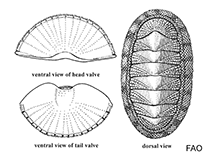Chiton squamosus unspecified
Squamose chiton| Native range | All suitable habitat | Point map | Year 2050 |

|
| This map was computer-generated and has not yet been reviewed. |
| Chiton squamosus AquaMaps Data sources: GBIF OBIS |
Upload your photos
Google image | No image available for this species;
drawing shows typical species in Chitonidae.
Google image | No image available for this species;
drawing shows typical species in Chitonidae.
Classification / Names Common names | Synonyms | CoL | ITIS | WoRMS
Polyplacophora | Chitonida | Chitonidae
Environment: milieu / climate zone / depth range / distribution range Ecology
Benthic; depth range 0 - 3 m (Ref. 2022). Tropical
Distribution Countries | FAO areas | Ecosystems | Occurrences | Introductions
Western Central Atlantic.
Length at first maturity / Size / Weight / Age
Maturity: Lm ? range ? - ? cm Max length : 7.6 cm TL male/unsexed; (Ref. 281)
Short description Morphology
Valves: Dull, ashen-gray with wide, irregular, dull-brown, longitudinal stripes. Posterior edge of first seven valves: Four or five squares of blackish brown. Lateral areas of middle valves: Six to eight rows of small beads between which are microscopic pinholes. Central areas: Smoothish, with fine, transverse scratches. Girdle: Alternating pale stripes of grayish green and grayish white (Ref. 281).
Life cycle and mating behavior Maturity | Reproduction | Spawning | Eggs | Fecundity | Larvae
Members of the class Polyplacophora are mostly gonochoric. Life cycle: Eggs hatch into lecitotrophic planktonic trocophore larvae (no veliger stage) which later metamorphose and settle on the bottom as young adults.
Main reference
References | Coordinator | Collaborators
Burghardt, G. and L. Burghardt. 2006. (Ref. 281)
IUCN Red List Status (Ref. 130435)
CITES status (Ref. 108899)
Not Evaluated
CMS (Ref. 116361)
Not Evaluated
Threat to humans
Human uses
| FishSource |
Tools
More information
Internet sources
BHL | BOLD Systems | CISTI | DiscoverLife | FAO(Publication : search) | Fishipedia | GenBank (genome, nucleotide) | GloBI | Gomexsi | Google Books | Google Scholar | Google | PubMed | Tree of Life | Wikipedia (Go, Search) | Zoological Record
Estimates based on models
Preferred temperature
(Ref. 115969): 26.4 - 28.3, mean 27.5 (based on 355 cells).
Price category
(Ref. 80766):
Unknown.



